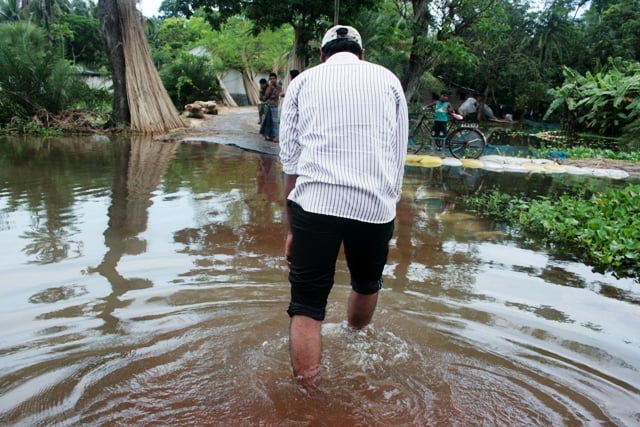“We live an inhuman life here,” Amina Hasan, a 37-year-old mother of three who lives in a water-logged village in Satkhira District, told IRIN. “We are farmers; we know agriculture, but now our fields are water - there is no way we can work, and there is nowhere for us to live in a clean or safe way.”
Estimates of the number of people affected by water-logging over time vary, but government data after heavy monsoon rains in 2011 indicated that more than 800,000 people were affected that year in Satkhira District alone.
An October 2013 report by Shushilan, a local NGO, says more than 21,000 families in Sathkira District are currently affected by water-logging.
While a variety of factors lead to water-logging, it is most pronounced in areas where the land is divided by raised earthen embankments or polders.
Research shows that the construction of embankments often results in increased river sedimentation: silt and dirt build up in riverbeds instead of being deposited on flat land during floods. This results in the riverbeds rising. When embankments are in place and water spills over the edge during a high tide or heavy rain, trapped water cannot recede, leading to water-logging, which has affected some areas for more than a decade.
Some experts and activists are now arguing that the best long-term solution is a greater focus on managing rivers rather than trying to control them.
Differing responses
“We have moved three times in the last decade due to water-logging,” Sufia Khanam, a health clinic worker in Shoriyulia, Satkhira District, said. “We have left our family land, left our farming plots because they are ponds now, and we live together in a small house without enough land to grow food for everyone.”
The coastal region of southwestern Bangladesh is an extremely vulnerable part of one of the most flood-prone countries in the world.
While some migrate, others have adjusted to the protracted flooding by cultivating fish, prawns, or shrimp.
“I had a lot of land from my father’s family so once it flooded I rented it to some shrimp businessmen and I have the money from that rental now,” said Bidan Dhar, a farmer in Jessore District.
Shrimp cultivation, however, is not without controversy.
Scientists say that using water-logged land for commercial cultivation of shrimp leads to increased water salinity, which causes soil to become infertile.
Some organizations say shrimp farms also mask water-logging’s problems instead of catalysing communities to demand long-term solutions.
“Shrimp is appealing because it is big money made off of a small amount of space,” Dillip Kumar Datta, a professor of environmental sciences at Khulna University, explained.
“But even in the best case, shrimp farming can last for an absolute maximum of 10 years - and by the time local people learn how to do shrimp well, the environment is so badly damaged they cannot turn back to farming when shrimp fail,” he said, citing research by local experts.
Let the rivers flow?
“Water-logging is engulfing communities, rivers are dying, and lives are becoming more difficult,” said Rezaul Haq, an adviser to Shushilan.
“The question before us is: when something has gone so terribly wrong and so many people are suffering, how do we change it without making it worse?”
Some experts favour Tidal River Management (TRM) to provide a long-term solution to water-logging. TRM reopens river flows by cutting through embankments at strategic locations and removing other impediments to natural water flow.
“TRM allows the river to do what people here let them do for so long before the embankments started to appear in the 1960s - flow into lowlands, deposit silt, which contributes to healthy soil, then flow out,” said Datta, the environmental sciences professor, echoing an Oxfam review which reported that TRM has been shown to make land cultivatable again in 1-2 years.
“These are wetlands, so we need to use a wetland system - the rivers should be naturally managed,” said Haq, adding that each community must make adjustments specific to their river.
“The communities here know what to do; it’s going back to what they did before the government introduced embankments,” he added.
kk/ds/cb
This article was produced by IRIN News while it was part of the United Nations Office for the Coordination of Humanitarian Affairs. Please send queries on copyright or liability to the UN. For more information: https://shop.un.org/rights-permissions





